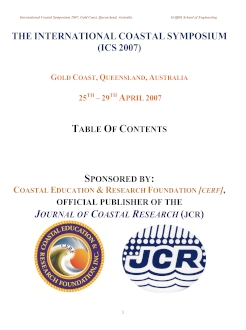Castelle, B., Turner, I.L., Ruessink, B.G., and Tomlinson, R.B., 2007. Impact of storms on beach erosion: Broadbeach (Gold Coast, Australia). Journal of Coastal Research, SI 50 (Proceedings of the 9th International Coastal Symposium), 534 – 539. Gold Coast, Australia, ISSN 0749.0208
The 70 km long Queensland Gold Coast has been one of Australia's premier coastal holiday resort destinations for more than 40 years. Extreme events, particularly tropical cyclones approaching the area, can generate storm waves and surges which have caused widespread episodic damage to the local economy. Broadbeach, located on the Gold Coast, is a double-barred beach which is representative of most of the Gold Coast beaches. The present study aims to quantify Broadbeach response to storm events in order to assess the ability of this beach to withstand extreme events and to recover during periods of lower wave energy. From the 1st of March to the 10th of July, 2006, 35 accurate subaerial beach surveys were undertaken. ARGUS images were used to estimate the location of the nearshore bars. During this period, Broadbeach experienced three storm erosion events. Offshore buoy measurements are used to estimate wave conditions that occurred. The first storm (from the 2nd to the 6th of March) was a hybrid-cyclone which generated one of the most energetic wave conditions on the Gold Coast of the past 30 years, with measured offshore significant wave height reaching 5.3 m, and maximum wave height 10.7 m at the Gold Coast Seaway buoy. During the two other storm wave events, wave conditions were much less energetic than during the first storm, with significant wave heights ranging from 2 to 3 m. The early March extreme event resulted in a 48m3/m erosion of the subaerial beach and a 70 m seaward migration of the outer bar in just a few days. Abnormally high erosion rates were measured during both the second and third storm wave events. This may be explained by the outer bar decay following the early March extreme event, which did not provide any significant protection during the subsequent two storm wave events. The severe erosion measured in this study suggests that the current average beach width may be too narrow to withstand an extreme event succession similar to the conditions that occurred in 1967.





